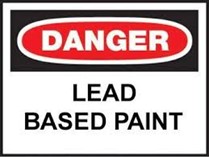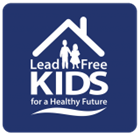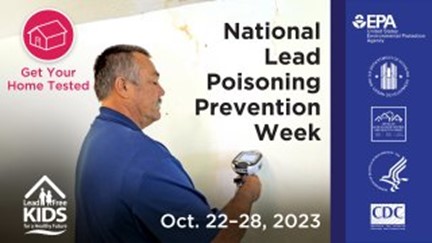It’s National Lead Poisoning Prevention Week
Each year, the U.S. Environmental Protection Agency (EPA) recognizes the fourth week of October as “National Lead Poisoning Prevention Week” so individuals, organizations, government agencies, and others can come together to educate the public on ways to reduce exposure to lead.

Get the Facts
- Lead is toxic, especially in young children. When lead is breathed in or swallowed, it can result in damage to the brain and nervous system, learning and behavior problems, slow growth and development, and hearing and speech problems.
- Lead poisoning is preventable! The key is preventing children from encountering lead.
- Lead can be found inside and outside the home. A common source of exposure is from deteriorated lead-based paint, which was used inside and outside many homes built before 1978. Children can be exposed by swallowing or breathing in lead dust created by old paint that has cracked or chipped; eating paint chips; and chewing on surfaces coated with lead dust and/or lead-based paint, such as windowsills.
- Other potential sources of lead include toys, painted furniture, metal or plastic jewelry, items made in other countries and imported into the United States (i.e., health remedies, foods and candies, cosmetics, powders, or make-up used in religious and cultural practices), lead-glazed pottery or porcelain, and collectibles that have been passed down.
- Along with young children, those at highest risk of lead poisoning include pregnant women and adults who work with batteries, do home renovations, or work in auto repair shops.
- Other health risks caused by lead exposure in adults include:
- Miscarriages
- Premature births
- Low birth weights
- High blood pressure
- Digestive problems
Lead Testing for Children Is Critical
- If you think your child has been exposed to lead, get your child tested.
- A simple blood test can detect lead. Consult with your healthcare provider or local clinic for advice on blood lead testing. If families do not have a healthcare provider or health insurance, they can call 311 to find a provider near them for low- or no-cost care. Families without a health care provider can also get an appointment to see a doctor and obtain a blood lead test through NYC Health + Hospitals by calling 347-507-3684.
- Act early. Children’s blood lead levels tend to increase from 6 to 12 months of age and tend to peak at 18 to 24 months of age.
- Blood tests are recommended for children living in a high-risk area or who have been exposed to lead.

Preventing Lead Exposure
The EPA recommends some simple steps to prevent lead exposure:
- Inspect and maintain all painted surfaces to prevent paint deterioration.
- Address water damage quickly.
- Keep your home clean and dust free; household dust from deteriorating lead-based paint or contaminated soil can be major sources of lead exposure for children.
- Let the water run to flush the tap, use only cold water to prepare food and drinks, and use a water filter (lead in older pipes can leach into drinking water).
- Tell children to keep their hands and toys out of their mouths and to wash their hands frequently.
NYCHA’s Environmental Health and Safety Department (EHS) would like to remind NYCHA staff that the following personal protective equipment (PPE) is available to help reduce potential lead exposure while working:
- Half-face masks or full-face PAPRs (powered air-purifying respirators), both with a P100 filter (P means that it protects against oil mists; 100 means that it protects against 99.99 percent of lead-based dust)
- Tyvek suits
- Latex gloves
- Shoe covers
- HEPA (high-efficiency particulate air filter) vacuums
- Dust shrouds (devices that attach to your tool and vacuum to create a controlled path for dust to travel)
The mission of EHS’s Lead Oversight Team (LOT) is to ensure that lead-related activities are done safely, and in compliance with all lead-based paint federal and local regulations as well as NYCHA’s Lead-Safe Housing standard procedures. By directly observing work that’s in progress, the LOT can provide immediate guidance to staff and vendors and ensure that any safety or regulatory violations are addressed and brought into compliance. The LOT also inspects development storerooms to verify that they are equipped with the necessary renovation, repair, and painting supplies, and the team visits management offices to ensure that lead disclosure folders are properly maintained.
If you have questions about this or any environmental health and safety matter, please email ehs@nycha.nyc.gov. Residents, employees, and any member of the public can submit environmental health and safety concerns at https://on.nyc.gov/submit-concern.
For more information about lead, please call 1-800-424-LEAD (5323) to speak with a specialist or visit the following links:







